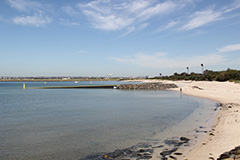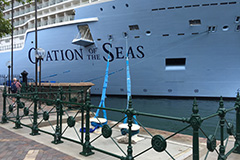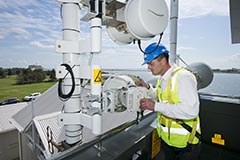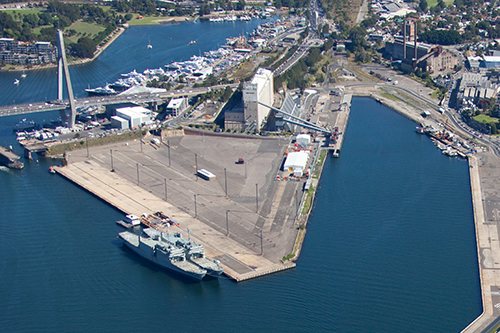Foreshore Beach was formed during the 1970s when land was reclaimed for the first Port Botany development. Since its formation, the beach showed signs of erosion with wave action generally transporting eroded sand northwards resulting in impacts on adjacent seagrass beds and, on occasions, obstructing stormwater outlets discharging along the beach causing upstream flooding.
The consent conditions issued for the second Port Botany development required the Port Authority to carry out a number of community enhancement projects, which amongst other things included construction of a boat ramp facility, rehabilitation of the Penrhyn Estuary, protection of seagrass beds and restoration and enhancement of Foreshore Beach including the adjoining landscape area.
The restoration work carried out at Foreshore Beach did not reduce ongoing beach erosion and in order to protect seagrass beds under obligations set out in the Port Botany Expansion Consent Conditions the Port Authority started investigations to identify options available to reduce sand movements. There was recognition by the Port Authority that a comprehensive solution to the erosion issue would need to include suitable treatment of the two stormwater outlets discharging along the beach. Accordingly, the Port Authority and Sydney Water (the owners of the stormwater infrastructure) agreed to jointly fund the investigation, design and construction of the solution to this issue.
In 2012 consultants were appointed to study the problem and to recommend options to address the issues. The study indicated that the construction of a series of groynes and extending the stormwater outlets further seawards was the preferred solution.
Groynes are coastal protection structures, usually made up of rock and aligned perpendicular to the beach extending from the beach down into deeper water. In Botany Bay there are existing groynes constructed at Kurnell, Lady Robinson’s Beach and Yarra Bay.
This concept of groynes was further refined through hydraulic model studies at the Manly Hydraulics laboratory. The final solution adopted comprised the construction of three groynes with two of the groynes incorporating the stormwater pipes which are extended seawards within those groynes. This arrangement permits efficient use of the structure where it not only serves its primary role in arresting drifting sand but also forms a protective housing for the extended stormwater pipes in withstanding sea actions such as waves and tides.
Location
Foreshore Beach is located on the western side of Foreshore Road at Botany and extends from the Boat Ramp to the Millstream near the airport.
Infrastructure details
The groynes at Foreshore Beach are of composite construction where the conventional rock construction is limited to the beach zone only and transitions into fibre reinforced plastic sheet piling as it extends into the water. A further innovative feature of this groyne is that the sheet piled section plunges below water as it extends seawards. This is mainly to achieve a better dissipation of rip currents in comparison to conventional constant height groynes.
The plunging sheet piled section has the potential to pose a danger to recreational small craft users at the beach. In order to indicate its presence, the sheet piles were topped with a yellow coloured angle section with two lit navigation marker piles, installed at the end and the middle of each groyne. The marker piles were also installed with yellow jackets.
The two groynes incorporating stormwater pipes are located over the existing pipes and are referred to by the name of the street within Bayside Botany Council area where the stormwater lines originate.
Livingstone Avenue groyne – This groyne incorporates the triple 1800 mm diameter pipes which are extended 42m seawards within the 46m long rock portion of the groyne. Beyond the end of the rock section the sheet pile section extends a further 106 m into the bay.
Chelmsford Avenue groyne – This groyne incorporates the single 1200 mm diameter pipe which is extended seawards 33.5m within the 37.6m long rock portion of the groyne. The sheet pile section extends a further 85.4 m into the bay.
Middle groyne – This groyne is located approximately midway between the two groynes that contain stormwater pipes but does not incorporate any pipes. It has a 13m long rock portion followed by a 126m long sheet pile section extending into the bay.
Protection of seagrass during execution of the works - seagrass surveys were carried out prior to contract works commencing as well as during and upon completion of the works.
- Port Botany Foreshore Beach Groynes - Pre-Construction Seagrass Survey
- Port Botany Foreshore Beach Groynes - Seagrass Survey During Construction
- Port Botany Foreshore Beach Groynes - Seagrass Survey After Construction
Community benefits
Foreshore Beach and the adjacent landscaped area is a popular recreational area with the public. It is also a designated dog walking beach. Sand nourishment carried out following completion of groyne construction has restored the beach amenity to a high standard. The performance of the beach will be monitored through surveys. As the groynes tend to compartmentalize the beach, cement grouted walkways are provided across each of the groynes for ease of crossing over the groynes.







